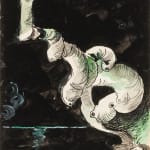Graham Sutherland 1903-1980
Tree Root, c.1939
Ink and watercolour on paper
13 x 10 3/4 in
33 x 27.5 cm
33 x 27.5 cm
Sutherland began to make paintings in which natural objects take on an anthropomorphic aspect in 1936, but the impact of seeing Picasso's Guernica and the related studies in the art...
Sutherland began to make paintings in which natural objects take on an anthropomorphic aspect in 1936, but the impact of seeing Picasso's Guernica and the related studies in the art and literary journal Cahiers d'Art in 1937 drove this element of his work to be the dominant factor; using found organic objects to suggest a human presence and a deep feeling of anxiety triggered by war.
Tree Root, which depicts a fallen tree with exposed roots, was created as part of a series of preparatory work for Sutherland’s solo exhibition at Leicester Galleries in 1940. The form brings to mind the contorted limbs of Matthias Grünewald's dying christ in his Isenheim Altarpiece (1506-15), which had previously been copied by Picasso and reproduced in Minotaure. A similar example to Tree Root, titled Green Tree Form: Interior of Woods (1940), exhibited in the fore-mentioned exhibition, was purchased by TATE and continues to form part of their collection.
Tree Root, which has never been offered for sale before, was gifted to Paul Drury; a lifelong friend of Sutherland, having met in the etching class of 1921 at Goldsmiths School of Art, where the pair would often overlap in subject matter. Throughout the course of the 1930s, Sutherland and Drury kept in close contact, Drury visited Sutherland on occasion at his home in Wales where they continued to share motifs, yet this was to be interrupted by preparations for the Second World War.
Sutherland and Drury corresponded over this period, Sutherland demonstrating concern over Kenneth Clarke’s selection of him as a war artist, moving Sutherland to his house at Upton. During the run-up to war and in the phoney war period, Sutherland went back to his beloved Wales, working on the content for his one man show at Leicester Galleries.
Although not documented in the correspondence, it was in 1939 or early 1940 that Tree Root was gifted to Drury. Other works gifted to Drury include Banana leaf and Landscape, which are now in the collection of the Museum of Wales.
Tree Root, which depicts a fallen tree with exposed roots, was created as part of a series of preparatory work for Sutherland’s solo exhibition at Leicester Galleries in 1940. The form brings to mind the contorted limbs of Matthias Grünewald's dying christ in his Isenheim Altarpiece (1506-15), which had previously been copied by Picasso and reproduced in Minotaure. A similar example to Tree Root, titled Green Tree Form: Interior of Woods (1940), exhibited in the fore-mentioned exhibition, was purchased by TATE and continues to form part of their collection.
Tree Root, which has never been offered for sale before, was gifted to Paul Drury; a lifelong friend of Sutherland, having met in the etching class of 1921 at Goldsmiths School of Art, where the pair would often overlap in subject matter. Throughout the course of the 1930s, Sutherland and Drury kept in close contact, Drury visited Sutherland on occasion at his home in Wales where they continued to share motifs, yet this was to be interrupted by preparations for the Second World War.
Sutherland and Drury corresponded over this period, Sutherland demonstrating concern over Kenneth Clarke’s selection of him as a war artist, moving Sutherland to his house at Upton. During the run-up to war and in the phoney war period, Sutherland went back to his beloved Wales, working on the content for his one man show at Leicester Galleries.
Although not documented in the correspondence, it was in 1939 or early 1940 that Tree Root was gifted to Drury. Other works gifted to Drury include Banana leaf and Landscape, which are now in the collection of the Museum of Wales.
Provenance
A gift from Sutherland to the artist Paul Drury; by descentJoin our mailing list
* denotes required fields
We will process the personal data you have supplied to communicate with you in accordance with our Privacy Policy. You can unsubscribe or change your preferences at any time by clicking the link in our emails.




